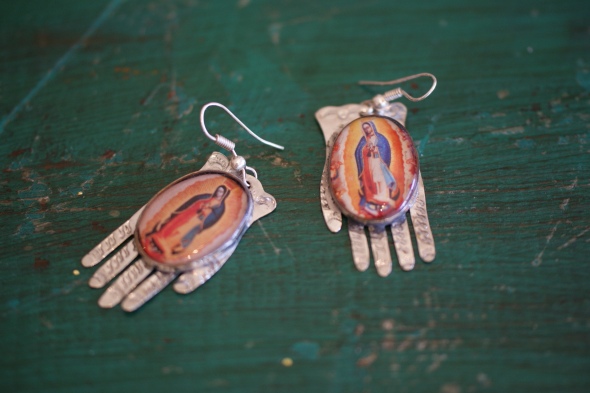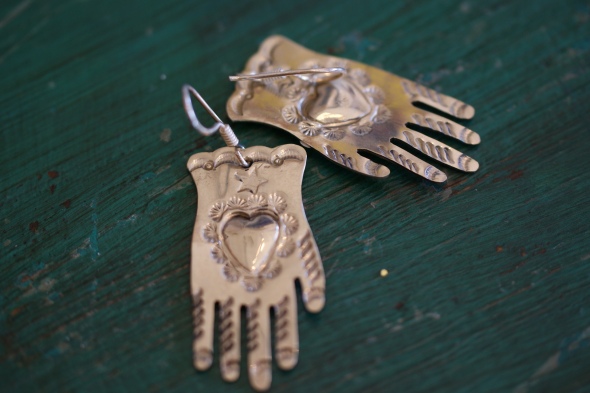Zinnia Mexican Folk Arts Shop
Posted: January 11, 2013 Filed under: Folk Art, Mexican Crafts, Mexican Folk Art, Mexican Style, Unique gifts & Jewelry, Zinnia Folk Arts Shop | Tags: Day of the Dead, Folk Art, handmade, Heron Martinez, Mexican ceramics, Mexican crafts, Mexican folk art, mexican style, Textiles Comments Off on Zinnia Mexican Folk Arts ShopI thought you might be interested in the most recent look at how we like to display Mexican folk art at Zinnia Folk Arts shop! We wanted to move the holiday decorations out so I decided to put the vintage (1960’s White Period) Heron Martinez tree of life in the front window and build a colorful support cast of a variety of Mexican crafts. The color is so welcome during these grey days in Minnesota…it’s actually raining today. Enjoy the photos and of course, if you’re in Minneapolis, stop in. We’ll be waiting for you. Saludos!
Custom Made Pinatas
Posted: December 17, 2012 Filed under: Folk Art, Mexican Crafts, Mexican Holidays, Mexican Style, Paper Mache, Pinatas, Unique gifts & Jewelry, Zinnia Folk Arts Shop | Tags: Celebrate the holidays, handmade, Mexican crafts, Mexican folk art, Mexican holidays, mexican style, paper folk art, paper mache, Pinatas Comments Off on Custom Made PinatasThis is the season for pinatas in Mexico. Big ones, small ones. The pinata maker in town will make lots of different ones to be purchased by families who will host the procession of visitors who go door to door looking for shelter–just like Mary and Joseph did so many thousands of years ago. The “Posadas” started yesterday, December 16th and will proceed every night until December 24th. The party at the last house will include the pinata game for children (and some adults). The pinatas traditionally have a clay pot in the center and then paper mache surrounding the pot and the star points. They come in lots of colors and sizes and designs and they are always a treat to see. Most public spaces will feature giant pinatas as decorations and they are especially gorgeous.
I have been embellishing pinatas since I started Zinnia Folk Arts several years ago and have several in the front of the store that I use for decoration. Over the years people have asked me to make them for their parties, bridal showers or weddings. This very pink pinata in the after photo is going to decorate a very sweet young girl’s room. I thought you’d be interested in seeing the before picture and the after. It used to be a Minnie Mouse pinata and now is a pink and green confection. Enjoy!
Here’s the before:
And here’s the after!
The Virgin of Guadalupe and Mexican Folk Art
Posted: December 12, 2012 Filed under: Mexican Crafts, Mexican Folk Art, Mexican Holidays, Mexican Style, Religious Folk Art, Unique gifts & Jewelry, Virgin of Guadalupe | Tags: basilica of guadalupe, handmade, Mexican crafts, Mexican folk art, Mexican holidays, mexican style, Religious folk art, Santos, Virgin of Guadalupe Comments Off on The Virgin of Guadalupe and Mexican Folk ArtIn Mexico, December 12 is the Fiesta of la Virgen de Guadalupe. Pilgrims from all over Mexico walk, ride buses, drive, ride bikes and even walk on their knees to arrive at the Basilica of Guadalupe that was built on the hill where Juan Diego saw the Virgin three times in the 1500’s. The tilma that was seen by Juan Diego is preserved in the Basilica and many, many people make pilgrimages to see it and to pray for help of all kinds. But it’s not just in Mexico City that people remember and celebrate her today–it’s everywhere in the country.
Guadalupe is a world-famous icon of the Virgin Mary. She is fondly known as the “Queen of Mexico.” Her image can be found everywhere in Mexico. She’s recognizable by the golden rays that surround her image and by the little cherub at her feet.
Here’s a photo of the original Basilica de Guadalupe in Mexico City.

Yes, it’s sinking! That’s partly why a new Basilica was built to the left of this photo. I like the old one better.
Light a candle and leave it outside one of several chapels on the Tepeyac Hill.
We carry 5″ tall Lux Candles. Take off the tissue paper and the lid, light it and wait for the image to be illuminated by the flame (it will take a while).
Folk artists use her image in every imaginable way and express their love and admiration for her through their media.
This is the Virgen de Guadalupe according to the Purepecha people of Michoacan. The whimsical Guadalupe wall plaque was made in Ocumicho.
Wooden bateas (carved trays) painted with the Virgin’s image come from Michoacan. These are decorative and are meant to be hung on the wall or set in a holder for display.
This is a reverse glass painting of la Virgen. The technique is an old-fashioned one but is being revived by a Mexico City artist, Manuel Bauman.
This is a large and lovely retablo with many saints on wood and painted in Michoacan. Available in the shop or by email!
This gorgeous tin cross decorated on the inside with Guadalupe and the symbolic roses comes from Oaxaca. Available in the shop or by email!
Nickel Silver earrings with the image of the Virgin available here.
And of course decorative boxes! These are especially lovely and very unique. They are from Mexico City. Available in the shop or by email.
New Mexican Silver Jewelry from Taxco And Other Places!
Posted: October 16, 2012 Filed under: .925 SIlver, Guatemala, Huichol, Jewelry, Mexican Crafts, Mexican Earrings, Mexican Folk Art, Mexican Jewelry, Mexican silver jewelry, Silver jewelry from Mexico, Unique gifts & Jewelry | Tags: Arracada, handmade, Mazahua lovebirds, Mexican crafts, Mexican folk art, Mexican jewelry, Mexican silver, Mexican Silver Earrings, Mexican Silver Jewelry, silver earrings Comments Off on New Mexican Silver Jewelry from Taxco And Other Places!Ok, it’s not ALL Mexican jewelry. The bead bracelets are from Guatemala–a very nice young man stopped in the shop with some beautiful bead work bracelets and I bought a few to see how they would sell. They are available right here. But if you’re looking for even nicer bead bracelets from Mexico, the handwork of the Huichol Indians is (in my mind) unsurpassed. Those exquisite and super liquid-y designs are right here but not in the above photo.
The slightly more contemporary designs of a Oaxacan arracada (bottom left corner and top right corner) are from another person who dropped into the shop, a Mexican-American woman visiting Minneapolis from Los Angeles. They are .925 silver and are beautiful. Fancy but not over the top. Those are available right here.
The lavender sachet is lovely and I bought a bunch of them in Guanajuato. They are embroidered and then some old Mexican coins are attached at the corner. Lovely gifts available here.
In the middle right box are a pair of Mazahua earrings with kissing lovebirds and a single drop. They are from just outside Mexico City and are a tried and true every day earring. The kissing birds are very typical of Mazahua earrings and they represent love, peace and serenity. Available here.
All of the others I purchased on my last trip to Mexico in Taxco. Some are traditional motifs and some are a twist on the traditional. One of them is an Aztec design combined with dangles to make a more contemporary earring. They are all sterling silver and they are all for pierced ears. Click on the following to find them:
Filigree Dangle, Upper left corner
Winged Birds with Dangles, Upper Middle (contact me, I forgot to put them on the website)
Oxidized Silver Sacred Hearts, Middle left
Aztec Motif with Dangles, Lower Middle
As always if you have any questions, please contact me below!
Saludos, Anne
Mexican Folk Art Plates from Delores Hidalgo, Mexico
Posted: September 20, 2012 Filed under: Clay Ceramics, Mexican Folk Art, Mexican Pottery, Mexican Style, Talavera, Unique gifts & Jewelry | Tags: Ceramics, handmade, Mexican ceramics, Mexican crafts, Mexican folk art, mexican style, talavera Comments Off on Mexican Folk Art Plates from Delores Hidalgo, Mexico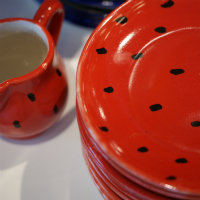

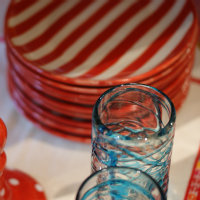
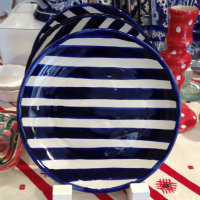
Summer is winding down in Minnesota, but if you aren’t quite ready to let it go (or you live in a warm weather climate all year-long–lucky you) take a look at this handmade Mexican folk art from the town of Delores Hidalgo. These cheerful Mexican crafts are made individually the old-fashioned way. Yes, on a wheel and then glazed and fired. They are safe for eating (no lead) and can go into the microwave and dishwasher. These somewhat low fired ceramics can chip so it’s a good idea to treat them with respect. (No juggling.)
Almost every region of Mexico makes objects out of clay. In the state of Guanajuato, Delores Hidalgo is known for making “talavera.” There are hundreds of shops selling a wide range of ceramics in varying levels of quality. Talavera is a style of ceramic work that was brought to Mexico by the Spaniards after the conquest in the 1500’s. The other city that is perhaps even more well-known for talavera and is home to many masters of the craft, is Puebla in the state of Puebla. Puebla is home to one of the best, Uriarte. The styles of the talavera in the two cities are somewhat different with Puebla being even more Spanish in tradition. Another offshoot of these functional Mexican crafts is “majolica” and that can be found principally in the city of Guanajuato. Gorky Gonzalez is one of the famous potters of Guanajuato and many people recognize the Gorky style immediately. Another well-known majolica artisan in the city of Guanajuato is Capelo.
The functional Mexican folk art ceramics of Mexico are beautiful and we carry a lot of them in the shop at Zinnia Folk Arts. Stop in to our Twin Cities store or take a look right here!
Handmade Silver Jewelry from Mexico
Posted: August 19, 2012 Filed under: .925 SIlver, Jewelry, Mexican Crafts, Mexican Earrings, Mexican Jewelry, Mexican Style, Unique gifts & Jewelry | Tags: handmade, Mexican crafts, Mexican jewelry, Mexican silver, silver earrings Comments Off on Handmade Silver Jewelry from MexicoHere are a few photos of our latest shipment of silver beauties from Mexico. Some of these pieces can be purchased from the website. If you’re interested in the others you can send me an email with an inquiry.
All of them are in the shop at 826 West 50th, Minneapolis, MN…612-824-4342…Gracias!
Whimsy And Mexican Folk Art
Posted: August 4, 2012 Filed under: Folk Art, Mexican Folk Art, Toys, Unique gifts & Jewelry, Wood Carvings, Zinnia Folk Arts Shop | Tags: Mexican dolls, Mexican folk art, mexican style, Mexican Toys, paper mache, Wood Carvings Comments Off on Whimsy And Mexican Folk ArtMany times when people look at Mexican folk art pieces in the shop, they ask about the meaning. And many pieces of Mexican folk art are derived from a long tradition of carving, potting, beading and a history unique to the particular region or pueblo from which that item came. But there are also pieces of folk art that are just fun and whimsical and may have an attenuated connection to the past and to a greater meaning but are like toys in that they are mostly for pure joy and amusement. Some of the most colorful and unique pieces of Mexican folk art are categorized in the arena of “toys.”
Though some of the pieces are not meant for children to literally play with, other pieces are. “The Mexican toy world is full of delightfully fantastic objects and peopled with fanciful animals…If all the types of toys could be gathered in one place, they would constitute a great ensemble of beauty, grotesqueness and humor. There would be clay, glass and petate (fiber) insects, birds and animals of all sizes and colors, some with whistles in their tails; animals playing instruments, pigs adorned with flowers, tin rattles…There are many household toys—furniture of all kinds, tiny perfectly formed sets of dishes, mortars and stoves. Dolls and marionettes made from wood or paper mache are common in many regions. The make believe world of children is generally like the adult world, filled with beliefs in magic and miracles…”
Frances Toor, A Treasury of Mexican Folkways
Dancing Mexican Day of the Dead Catrinas
Posted: July 7, 2012 Filed under: Day of the Dead, Mexican Folk Art, Paper Mache, Unique gifts & Jewelry | Tags: Day of the Dead, handmade, Mexican folk art, paper mache Comments Off on Dancing Mexican Day of the Dead CatrinasThese lovely dancing ladies come from Michoacan, Mexico and are made of paper mache. I continue to be totally in awe of what Mexican artisans can do with paper and paper mache. They stand on their own, holding their skirts as they anticipate swirling. Remember? Mexican Day of the Dead skeletons do everything in the afterlife that they did while living. And they always do it with a smile. The colors of their dresses are lovely too–orange and blue, purple, pink and teal and pink with purple. $40 each.
Huichol Beaded Mexican Folk Art Jewelry
Posted: June 25, 2012 Filed under: Huichol, Mexican Folk Art, Mexican Jewelry, Unique gifts & Jewelry | Tags: handmade, Huichol, Mexican folk art, Mexican jewelry Comments Off on Huichol Beaded Mexican Folk Art JewelryForget everything you’ve ever thought about Mexican beaded bracelets. You know, they’re nice but nothing spectacular. The Huicholes of Nayarit, Mexico, design and create the most exquisite jewelry from beads that you’ve ever seen. And I mean, ever! The color combinations, the designs and the liquid ease that they drape on the wrist are exceptional. Treat yourself (or someone you love) to something unique right here.


